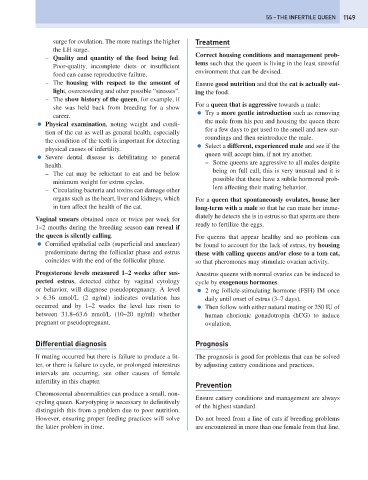Page 1157 - Problem-Based Feline Medicine
P. 1157
55 – THE INFERTILE QUEEN 1149
surge for ovulation. The more matings the higher Treatment
the LH surge.
Correct housing conditions and management prob-
– Quality and quantity of the food being fed.
lems such that the queen is living in the least stressful
Poor-quality, incomplete diets or insufficient
environment that can be devised.
food can cause reproductive failure.
– The housing with respect to the amount of Ensure good nutrition and that the cat is actually eat-
light, overcrowding and other possible “stresses”. ing the food.
– The show history of the queen, for example, if
For a queen that is aggressive towards a male:
she was held back from breeding for a show
● Try a more gentle introduction such as removing
career.
the male from his pen and housing the queen there
● Physical examination, noting weight and condi-
for a few days to get used to the smell and new sur-
tion of the cat as well as general health, especially
roundings and then reintroduce the male.
the condition of the teeth is important for detecting
● Select a different, experienced male and see if the
physical causes of infertility.
queen will accept him, if not try another.
● Severe dental disease is debilitating to general
– Some queens are aggressive to all males despite
health.
being on full call, this is very unusual and it is
– The cat may be reluctant to eat and be below
possible that these have a subtle hormonal prob-
minimum weight for estrus cycles.
lem affecting their mating behavior.
– Circulating bacteria and toxins can damage other
organs such as the heart, liver and kidneys, which For a queen that spontaneously ovulates, house her
in turn affect the health of the cat. long-term with a male so that he can mate her imme-
diately he detects she is in estrus so that sperm are there
Vaginal smears obtained once or twice per week for
ready to fertilize the eggs.
1–2 months during the breeding season can reveal if
the queen is silently calling. For queens that appear healthy and no problem can
● Cornified epithelial cells (superficial and anuclear) be found to account for the lack of estrus, try housing
predominate during the follicular phase and estrus these with calling queens and/or close to a tom cat,
coincides with the end of the follicular phase. so that pheromones may stimulate ovarian activity.
Progesterone levels measured 1–2 weeks after sus- Anestrus queens with normal ovaries can be induced to
pected estrus, detected either by vaginal cytology cycle by exogenous hormones.
or behavior, will diagnose pseudopregnancy. A level ● 2 mg follicle-stimulating hormone (FSH) IM once
> 6.36 nmol/L (2 ng/ml) indicates ovulation has daily until onset of estrus (3–7 days).
occurred and by 1–2 weeks the level has risen to ● Then follow with either natural mating or 250 IU of
between 31.8–63.6 nmol/L (10–20 ng/ml) whether human chorionic gonadotropin (hCG) to induce
pregnant or pseudopregnant. ovulation.
Differential diagnosis Prognosis
If mating occurred but there is failure to produce a lit- The prognosis is good for problems that can be solved
ter, or there is failure to cycle, or prolonged interestrus by adjusting cattery conditions and practices.
intervals are occurring, see other causes of female
infertility in this chapter.
Prevention
Chromosomal abnormalities can produce a small, non-
Ensure cattery conditions and management are always
cycling queen. Karyotyping is necessary to definitively
of the highest standard.
distinguish this from a problem due to poor nutrition.
However, ensuring proper feeding practices will solve Do not breed from a line of cats if breeding problems
the latter problem in time. are encountered in more than one female from that line.

